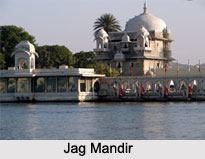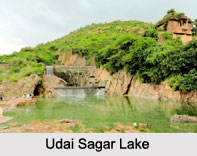 Tourism in Udaipur includes major attractions surrounded by Aravalli Mountain Ranges. This medieval city of Rajasthan has tourism attractions like Lake Palace, Udaipur City Palace, Jag Mandir, Monsoon Palace, Ahar Museum, Jagdish Temple, Deen Dayal Upadhyay Park, Fateh Sagar Lake, Pichola Lake, Saheliyo-ki-Bari, Sajjan Niwas Garden (Gulab Bagh Zoo), Sukhadia Circle, Bharatiya Lok Kala Mandal, Shilpgram, Udai Sagar Lake, Doodh Talai Lake, Jaisamand Lake and many others.
Tourism in Udaipur includes major attractions surrounded by Aravalli Mountain Ranges. This medieval city of Rajasthan has tourism attractions like Lake Palace, Udaipur City Palace, Jag Mandir, Monsoon Palace, Ahar Museum, Jagdish Temple, Deen Dayal Upadhyay Park, Fateh Sagar Lake, Pichola Lake, Saheliyo-ki-Bari, Sajjan Niwas Garden (Gulab Bagh Zoo), Sukhadia Circle, Bharatiya Lok Kala Mandal, Shilpgram, Udai Sagar Lake, Doodh Talai Lake, Jaisamand Lake and many others.
Lake Palace of Udaipur
Lake Palace of Udaipur overlooks Pichola Lake, now converted into a heritage hotel. It has a wonderful collection of courtyards, pavilions, hanging gardens and a lot more. Lake Palace was built in between 1743 to 1746. It was specially the winter palace for the royal families of Mewar.
City Palace of Udaipur
City Palace of Udaipur is a beautiful monument built of marble in flamboyant style of Rajput architecture. A number of architectural and artistic wonders are present in the City Palace of Udaipur.
Ahar
Ahar has several cenotaphs which commemorate the Royal Status of Mewar. The cenotaph of Maharana Amar Singh attracts the tourists for its architecture.
 Ahar Archaeological Museum
Ahar Archaeological Museum
Ahar Archaeological Museum is an archaeological museum of antiques of ancient historical rulers and the medieval Hindu kings.
Jagdish Temple
Jagdish Temple attracts the tourists for its intricate sculptural works. It was built by Maharana Jagat Singh in 1651. This is a Hindu temple dedicated to Lord Vishnu.
Fateh Sagar Lake
Fateh Sagar Lake is an artificial lake surrounded by Aravalli Mountain Range. This lake is named after Maharana Fateh Singh. Udaipur Observatory is located on the middle of this lake.
Pichola Lake
Pichola Lake is an artificial freshwater lake in Udaipur, created in 1362 AD, by the people of Rajasthan.
Jag Mandir
Jag Mandir is a palace built on Pichola Lake. This place was used as the summer resort for the kings of Mewar and Prince Khurram (later known as Mughal Emperor Shah Jahan).
Saheliyo-ki-Bari
Saheliyon-ki-Bari now acts as an eco tourism spot in Udaipur. This garden is located in northern part of Udaipur.
 Gulab Bagh
Gulab Bagh
This is considered as the largest zoo and the garden in Udaipur. Built by Maharana Sajjan Singh, Gulab Bagh includes Saraswati Library, Navlakha Mahal, Kamal Talai and Miraj Jyotish Upavan.
Bagore ki Haveli
It is a place of over one hundred rooms now converted into a museum. It was built by Amir Chandra Badwa, the Prime Minister of Mewar in 18th Century.
Udaipur Solar Observatory
This heritage building is located on Fateh Sagar Lake. It was built in 1976 by Dr. Arvind Bhatnagar.
Udai Sagar Lake
It is also a man made lake built by Maharana Udai Singh in 1565.
Haldighati
Haldighati is a mountain pass in Aravalli Range, popular for the battle of Haldighati, which was fought by Kingdom of Mewar against the Mughals.
Doodh Talai Lake
Doodh Talai Lake is a small lake located adjacent to Pichola Lake. Near this lake is located Shiva Niwas Palace which was the residence of Maharana Fateh Singh.



















